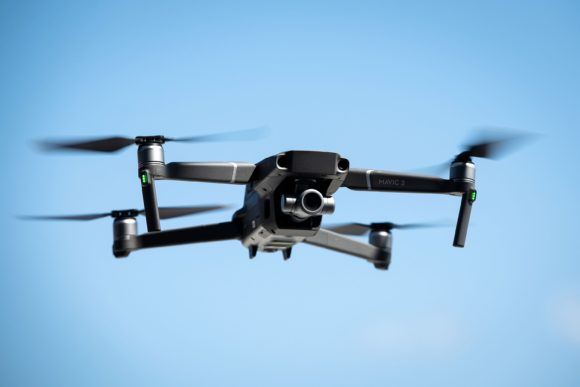A small drone was almost certainly the object that damaged a news helicopter flying over Los Angeles last year, and the remote-controlled devices are suspected in two other mid-air impacts with aircraft, according to U.S. investigators.
A KABC-TV chopper was struck about 1,100 feet above sea level in the vicinity of Los Angeles City Hall on the evening of Dec. 4, 2019, prompting the pilot to land after hearing a loud noise, the National Transportation Safety Board said in a report on the incident.
The object left a hole in the helicopter’s tail structure, “a small gouge” punched into one of its blades and dented and scuffed the rear of the craft, according to the report. The report was completed June 29, but wasn’t announced by the agency.
The NTSB’s findings are the latest indication of the growing risks of the millions of civilian drones in operation across the U.S. In addition to the three previously documented drone collisions, the safety board in its report on the Los Angeles incident said it now suspects the devices were involved in two other cases, an impact with a helicopter in Hawaii and a small plane in Oregon, both in 2018.
None of the cases led to injuries, but the small devices have hit with enough force to pierce metal structures, according to investigators.
Though a drone in the Los Angeles case was never found, evidence in the chopper’s damaged areas pointed to such a device. Tests revealed the presence of polycarbonate, a material used to make “an exemplar popular drone,” around the area of impact.
The damaged areas were consistent with the shape of a small drone and a computerized reconstruction of the impact by investigators predicted damage similar to what was found. There also was no biological evidence of bird remains.
“Although no drone was located, preventing complete certainty, all the available evidence was consistent with a collision with a small UAS,” the NTSB said in its report, using the acronym for unmanned aircraft system.
A physical search didn’t find a downed drone in the area at the time, the report said. It additionally notes two drone detection companies in the vicinity said they “did not have any targets in the area at the time,” although both companies “reported less than complete coverage of the area.”
The helicopter’s pilot, who’d logged more than 3,700 hours flying at the time of the collision, said he’d never seen a small drone while flying the chopper, according to the report.
KABC reporter Chris Cristi, who was aboard the helicopter when it was struck, told Good Morning America that the occupants initially assumed they’d hit a bird, but realized something else was the case upon landing. “It was a scary couple of minutes, and we were all looking at each other, you know, looking for a spot to land, and we eventually put it down and fortunately, everyone’s OK,” Cristi said in the interview.
The Federal Aviation Administration generally forbids small drone users from flying the devices beyond their line of sight and no more than 400 feet above them.
The FAA is finalizing regulations that would for the first time require civilian drones to broadcast their identity and location, a measure designed in part to lower the risks of mid-air collisions.
Through June 2019, there had been more than 8,700 reports received by the FAA of drones flying in prohibited areas or in an unsafe manner. There are typically more than 200 such incidents a month when the weather is warmer, according to FAA data.
The first mid-air collision involving a drone occurred on Sept. 21, 2017. The small quad copter operated by a civilian in Brooklyn crashed into an Army helicopter 2.5 miles away from him during a time when the United Nations General Assembly was meeting and flights in the area by civilian aircraft were prohibited, the NTSB found.
Was this article valuable?
Here are more articles you may enjoy.


 Property Restoration Industry: A Culture in Need of Repair?
Property Restoration Industry: A Culture in Need of Repair?  Hawaiian Electric Hits 40-Year Low Ahead of Maui Fire Report
Hawaiian Electric Hits 40-Year Low Ahead of Maui Fire Report  Vintage Ferrari Owners’ Favorite Mechanic Charged With Theft, Fraud
Vintage Ferrari Owners’ Favorite Mechanic Charged With Theft, Fraud  Synopsys Sued by Private Equity Firm for Shopping $3 Billion Unit
Synopsys Sued by Private Equity Firm for Shopping $3 Billion Unit 